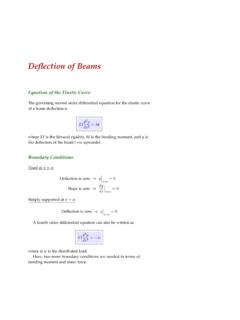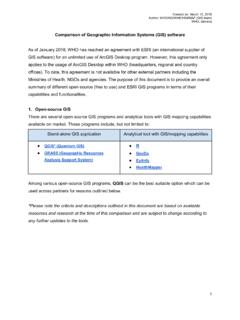Transcription of MANAGING THE DEVELOPMENT OF LARGE SOFTWARE …
1 MANAGING THE DEVELOPMENT OF LARGE SOFTWARE SYSTEMS Dr. Winston W. Rovce INTRODUCTION l am going to describe my pe,-.~onal views about MANAGING LARGE SOFTWARE developments. I have had various assignments during the past nit,.: years, mostly concerned with the DEVELOPMENT of SOFTWARE packages for spacecraft mission planning, commanding and post-flight analysis. In these assignments I have experienced different degrees of successwith respect to arriving at an operational state, on-time, and within costs. I have become prejudiced by my experiences and I am going to relate some of these prejudices in this presentation.
2 COMPUTER PROGRAM DEVELOPMENT FUNCTIONS There are two essential steps common to all computer program developments, regardless of size or complexity. There is first an analysis step, followed second by a coding step as depicted in Figure 1. This sort of very simple implementation concept is in fact all that is required if the effort is sufficiently small and if the final product is to be operated by those who built it - as is typically done with computer programs for internal use. It is also the kind of DEVELOPMENT effort for which most customers are happy to pay, since both steps involve genuinely creative work which directly contributes to the usefulness of the final product.
3 An implementation plan to manufacture 13rger SOFTWARE systems, and keyed only to these steps, however, is doomed tofailure. Many additional DEVELOPMENT steps are required, none contribute as directly to the final product as analysis and coding, and all drive up the DEVELOPMENT costs. Customer personnel typically would rather not pay for them, and DEVELOPMENT personnel would rather not implement them. The prime function of management is to sell these concepts to both groups and then enforce compliance on the part of DEVELOPMENT personnel. ANALYSIS CODING Figure 1. Implementation steps to deliver a small computer program for internal operations.
4 A more grandiose approach to SOFTWARE DEVELOPMENT is illustrated in Figure 2. The analysis and coding steps are still in the picture, but they are preceded by two levels of requirements analysis, are separated by a program design step, and followed by a testing step. These additions are treated separately from analysis and coding because they are distinctly different in the way they are executed. They must be planned and staffed differently for best utilization of program resources. Figure 3 portrays the iterative relationship between successive DEVELOPMENT phases for this scheme. The ordering of steps is based on the following concept: that as each step progresses and the design is further detailed, there is an iteration with the preceding and succeeding steps but rarely with the more remote steps in the sequence.
5 The virtue of all of this is that as the design proceeds the change process is scoped down to manageable limits. At any point in the design process after the requirements analysis is completed there exists a firm and c~seup~ moving baseline to whi(:h to ~turn in the event of unforeseen design difficulties. What we have is an effective fallback position that tends to maximize the extent of early work that is salvageable and preserved. Reprinted from Proceedings, IEEE WESCON, August 1970, pages 1-9. Co_pyright 1_9_70 by The Institute of Electrical and Electronics Et)gineers,, .328 Inc. Originally published by TRW.
6 I SYSTE M I ANALYSIS PROGRAM DESIGN I coo,.o TESTING I OPERATIONS Figure 2. Implementation steps to develop a LARGE computer program for delivery to a customer. I believe in this concept, but the implementation described above is risky and invites failure. The problem is illustrated in Figure 4. The testing phase which occurs at the end of the DEVELOPMENT cycle is the first event for which timing, storage, input/output transfers, etc., are experienced as distinguished from analyzed. These phenomena are not precisely analyzable. They are not the solutions to the standard partial differential equations of mathematical physics for instance.
7 Yet if these phenomena fail to satisfy the various external constraints, then invariably a major redesign is required. A simple octal patch or redo of some isolated code will not fix these kinds of difficulties. The required design changes are likely to be so disruptive that the SOFTWARE requirements upon which the design is based and which provides the rationale for everything are violated. Either the requirements must be modified, or a substantial change in the design is required. In effect the DEVELOPMENT process has returned to the origin and one can expect up to a lO0-percent overrun in schedule and/or costs.
8 One might note that there has been a skipping-over of the analysis and code phases. One cannot, of course, produce SOFTWARE without these steps, but generally these phases are managed with relative ease and have little impact on requirements, design, and testing. In my experience there are whole departments consumed with the analysis of orbit mechanics, spacecraft attitude determination, mathematical optimization of payload activity and so forth, but when these departments have completed their difficult and complex work, the resultant program steps involvea few lines of serial arithmetic code. If in the execution of their difficult and complex work the analysts have made a mistake, the correction is invariably implemented by a minor change in the code with no disruptive feedback into the other DEVELOPMENT bases.
9 However, I believe the illustrated approach to be fundamentally sound. The remainder of this discussion presents five additional features that must be added to this basic approach to eliminate most of the DEVELOPMENT risks. 329 I system ! REQUIREMENTSIBI~ ~"'i so,w.,~ I ANALYSIS ~1111~ I I pRI~OGRAM ~lll I CODING Ii TESTING OPERATIONS Figure 3. Hopefully, the ~terat=ve interact=on between the various phases is confined to successive steps. I system "1 .~oo,.~-,..Sl.,~ I so, ~ !. I ANALYSIS PROGRAM DESIGN I coo,.G I,~ ! TESTING I I O . ! Figure 4. Unfortunately, for the process illustrated, the design iterations are never confined to the successive steps.
10 330 STEP 1: PROGRAM DESIGN COMES FIRST The first step towards a fix is illustrated in Figure 5. A preliminary program design phase has been inserted between the SOFTWARE requirements generation phase and the analysis phase. This procedure can be criticized on the basis that the program designer is forced to design in the relative vacuum of initial SOFTWARE requirements without any existing a result, his preliminary design may be substantially in error as compared to his design if he were to wait until the analysis was complete. This criticism is correct but it misses the point. By this technique the program designer assures that the SOFTWARE will not fail because of storage, timing, and data flux reasons.









